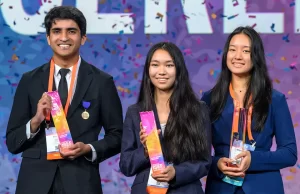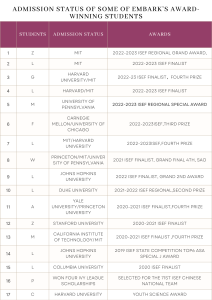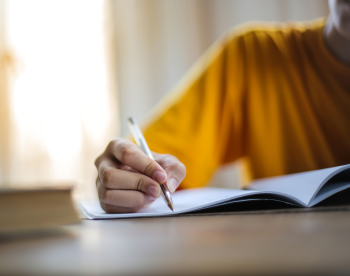Empowering Youth Innovation: Highlights from the 2024 ISEF Global Finals
Just in the early morning of May 18th, Beijing time! The 75th ISEF Global Finals came to an end in Los Angeles, USA . After fierce competition among nearly 2,000 young scientists from nearly 70 countries and regions around the world, major heavyweight awards were officially announced!
In this top academic feast, Embark students returned with great honors and once again broke the historical record! Our students won over 100+ awards in the preliminaries and finals, including 20+ ISEF global finals awards (an average of two or more awards per student). Not only that, Embark students have won multiple first-class awards for 2 consecutive years. prize ! Picked my own asteroid for 3 consecutive years !
Embark Students Shine at 2024 ISEF with Record-Breaking Awards
- 2024 ISEF Grand Fianal Team Embark Winning awards:
Top Award:1
First Place Award :2
Second Place Award :2
Asteroid naming rights:4(Won for three consecutive years)
Third Place Award :2
Fourth Place Award :3
Special Award :10+
ISEF Finalist(Global Division):20/40
Summary:Finals advancement rate-49% 、Finals winning rate-51%、Preliminary winning rate-92%
This step is the starting point for them to illuminate the world with the light of scientific research, and is their firm step to explore the unknown and pursue the truth. I look forward to them continuing to shine in their future scientific research and bringing more light and hope to the world!
2024 ISEF Champions
Under such fierce competition, which country's player will win the championship this year? Let ’s take a look at the list of grand prize winners in the finals
- Grace Sun, 16, of Lexington, Kentucky, won first place and received the $75,000 George D. Yancopoulos Innovator Award for her research on building a better organic electrochemical transistor that she hopes will be used to develop new electronic devices that could help detect and treat serious illnesses like diabetes, epilepsy and organ failure. To overcome the problems that have previously prevented such devices from working effectively inside the body, Grace developed a new way of chemically treating their organic components, which greatly improved their laboratory performance.
- Michelle Wei, 17, of San Jose, California, received one of two Regeneron Young Scientist Awards of $50,000 for her research to improve the speed and efficiency of a type of software that is useful in many fields such as machine learning, transportation and financial systems. Michelle’s new approach involved determining a quick approximate solution to the second-order cone programming problem, then splitting the initial cone into smaller cones, which enabled her new algorithm to greatly outperform previous approaches.
- Krish Pai, 17, of Del Mar, California, received the second Regeneron Young Scientist Award of $50,000 for his machine-learning research to identify microbial genetic sequences that can be modified to biodegrade plastic. His new software, called Microby, scans databases of microorganisms and determines which ones can be changed genetically to biodegrade plastics. In tests, he identified two microorganisms that can be genetically modified to degrade plastic at a cost he believes would be ten times less than traditional recycling.
- Other top honors from the competition include:
Justin Huang and Victoria Ou, both 17, of Woodlands, Texas, received the Gordon E. Moore Award for Positive Outcomes for Future Generations of $50,000 for their new prototype filtration system that uses ultrasonic waves to remove microscopic plastic particles from water. In lab tests, the acoustic force from the high-frequency sound waves removed between 84% and 94% of the suspended microplastic particles in a single pass. The students are now working to scale up and fine-tune their experimental system.
Ingrid Wai Hin Chan, 17, of Hong Kong, China received the Craig R. Barrett Award for Innovation of $10,000 for her research on using a multi-sensory therapy for dementia patients. Her mixed therapy app would allow patients to practice physical and cognitive skills through a personalized, immersive environment using virtual reality headsets. Ingrid conducted an eight-week study with six people living with dementia and found that the cognitive function of patients who used her prototype improved in several areas. She believes her app could serve as a viable option for dementia patients with limited access to in-person professional therapy.
Tanishka Balaji Aglave, 15, of Valrico, Florida, received the H. Robert Horvitz Prize for Fundamental Research of $10,000 for her investigation into a natural alternative treatment against citrus greening, a disease that threatens citrus farming in many parts of the world and is currently only treated with antibiotics. Tanishka injected the trunks of infected trees with an extract from the curry leaf tree, and found through tests that this potential method could effectively and sustainably manage citrus greening disease.
Maddux Alexander Springer, 18, of Honolulu, Hawaii, received the Peggy Scripps Award for Science Communication of $10,000 for his research into fibropapillomatosis (FP), a disease that is the primary cause of death in green sea turtles. Some turtles he studied in Kaneohe Bay, Hawaii, were stricken with a disease that causes internal and external tumors that inhibit their everyday lives. After analyzing the turtles’ diet of green algae, Maddux concluded that this disease, wastewater, invasive algae and the amino acid arginine all pose a grave risk to these endangered sea creatures.
Ria Kamat, 17, of Hackensack, New Jersey; Anna Oliva, 17, of Houston, TX; and Shuhan Luo, 18, of Worcester, MA, received the Dudley R. Herschbach SIYSS Award, which provides finalists an all-expense paid trip to attend the Stockholm International Youth Science Seminar during Nobel Week in Stockholm, Sweden.
Jack Shannon, 18, of Clane, Kildare, Ireland, and Nikhil Vemuri, 17, of Cary, North Carolina, received the EU Contest for Young Scientists Award. Their projects will represent Regeneron ISEF at the EU Contest for Young Scientists to be held this September in Katowice, Poland.
Embark’s U.S. undergraduate application status of some award-winning students
In fact, among the students admitted to TOP universities every year .Many have achieved good results in ISEF

This valuable experience in scientific research competitions not only greatly enhances students' comprehensive strength, but also enables them to stand out in the fierce application process for studying abroad!
Do you also have a dream of scientific research and are eager to use scientific innovation to knock on the door of Ivy League schools? Now let us have an in-depth understanding of the path to ISEF participation!
What is ISEF?
Regeneron ISEF, the full name of the International Science and Engineering Fair, is sponsored by Regeneron Pharmaceuticals and is also known as Regeneron ISEF. It is the world's most important youth scientific research and innovation competition.
ISEF is open to middle school students in grades 9 to 12 around the world and covers almost all subjects, including 22 sub-disciplines such as physics, chemistry, computers, engineering, social sciences, and biology.
Why attend ISEF?
ISEF is known as the "World Cup of Science and Technology" for teenagers. It is large in scale and high in gold content. It is also one of the high-level scientific research events recommended by MIT's official website! The professionalism and rigor of its review are a strong guarantee for the academic standards of the competition.
Not only that, ISEF can also help top university applications in the following three aspects
Academic ability
The competition for studying abroad is becoming increasingly fierce, and there are an endless stream of applicants with outstanding test scores. Based on the information from the official website of Top American University, admissions officers expressed that they most hope to see certain research abilities from international students, especially Chinese students . ISEF's status in the academic field is undoubtedly the best choice.
Research potential For Top American University, a meaningful research experience is an important factor in determining whether a student
Research potential
For Top American University, a meaningful research experience is an important factor in determining whether a student is truly passionate about a certain field and has the potential to become a future leader in that field. Being able to participate in ISEF in high school and complete a scientific research project that can only be studied at university or higher level proves the student's ability to in-depth exploration of a certain scientific research field and academic potential.
Resume Reflection
There is an extracurricular activity in the Common App or other application forms of American universities, and one of the options is scientific research . The ISEF participation experience can showcase students' scientific research achievements, and the experience of participating in the ISEF finals is enough to make students receive high attention during the application stage.
The ISEF participation path is complicated , starting from the affiliated competition and advancing to the ISEF finals. Some regions even need to start preparing projects a year in advance , constantly polishing, participating, and passing through many hurdles before they have a chance to compete for tickets to the global finals!
Reference sources:https://www.societyforscience.org/





